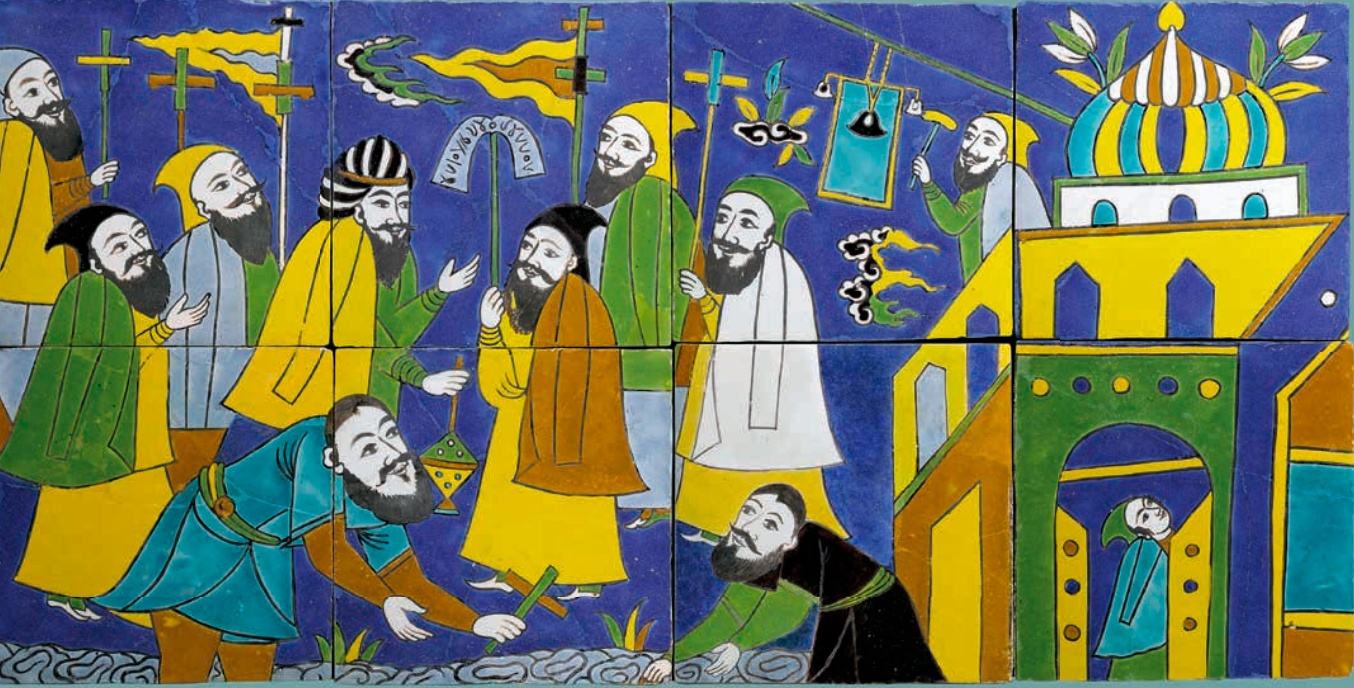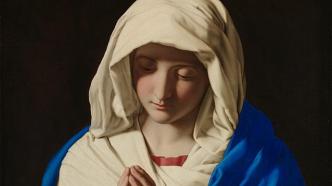
Recently, the Shanghai Museum announced that it will hold "From Botticelli to Van Gogh: The Collection of the National Gallery of England" together with the National Gallery of England, which has attracted a lot of attention. The exhibition is scheduled to open on January 17, when Botticelli, Raphael, Titian, Gossett, Caravaggio, Rembrandt, Claude, Constable, Cezanne, Manet, 52 oil paintings by European masters of Monet and Van Gogh will be exhibited in Shanghai, China. How to use more than 50 works to tell 400 years of European painting history? In addition to the absent "Sunflower", what other treasures come to Shanghai?

Messina, "Saint Jerome in the Study"
As one of the top ten most popular art museums in the world, the National Gallery has a collection of more than 2,600 masterpieces of European painting, including artists such as Gentileschi, Bellini, Cezanne, Degas, Da. Vinci, Monet, Raphael, Rembrandt, Renoir, Rubens, Titian, Turner, Van Dyck, Van Gogh and Velázquez. Exhibits are rarely outreached elsewhere. At present, the National Gallery of England is preparing for the 200th anniversary celebration of its establishment in 2024. The building in Trafalgar Square will undergo major renovations, which will also allow a batch of cultural relics to come to Asia.
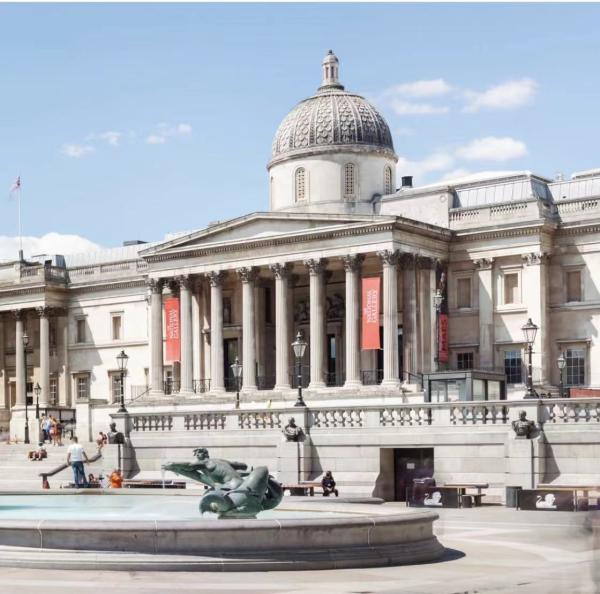
National Gallery in London
According to the exhibition list announced by the organizer, the special exhibition covers 52 works by 50 art masters, and will present a complete history of European painting from the Renaissance to the post-Impressionism of the 19th century. In order to better present this epitome of European art history spanning more than 400 years, the selection of exhibits should cover representative artists or masterpieces of each period as much as possible, ranging from Botticelli, Bellini, Raphael, Titian , Tintoretto, Gosset, Caravaggio, Poussin, Velázquez, Van Dyck, Rembrandt, Goya, Cezanne, Gauguin, Manet, Monet, Van Gogh, Constable, Turner, etc., are all masters of art in the history of art.
Chu Xiaobo, director of the Shanghai Museum, previously revealed at the press conference that the Shanghai Museum had twice proposed to borrow Van Gogh's most famous "Sunflower" for exhibition in Shanghai, but this masterpiece was exhibited in the Tokyo Olympics. During this period, I left the UK to Japan for an Asian tour, which is not suitable for "long-distance travel" in the short term.
Instead, the Van Gogh works on display will be "Long Meadow and Butterfly" hanging next to "Sunflower" in the exhibition hall, which is also a major exhibit. Vincent van Gogh painted this meadow while undergoing treatment at the Saint-Paul de Mausole near the town of St-Rémy in southern France. Van Gogh used a brush to perceive life, and painted the world with bright and rich colors, making his works full of vitality. At the press conference, Dr. Gabriel Fernaldi, director of the British National Gallery, stood in front of this work and introduced the special exhibition to the Chinese audience enthusiastically through video. He said it was "an exhibition that condenses the essence of the National Gallery's collection".
Leonardo da Vinci's "The Virgin of the Rocks" is one of the most important collections of the British National Gallery. The British side once said that the digital exhibition of this work can be brought to China, but the Shanghai Museum hopes to bring the original work and the digital exhibition at the same time. Presented to the domestic audience. The British side has repeatedly studied this, and believes that this work is an early wood-panel painting with a fragile material, and is no longer exhibited abroad due to cultural relic protection considerations.
Although I regret not being able to see "Sunflower" and Da Vinci's paintings exhibited in Shanghai, the exhibition can still be described as a collection of famous masterpieces. Before the exhibition officially opens, you may wish to have a look at some of the exhibits.

Botticelli "The Three Miracles of San Zenobius"
The Three Miracles of San Zenobius, the second in a series of four paintings by Botticelli, tells the story of San Zenobius, patron of Florence. Botticelli shows three miracles the saint performed on the streets of Florence. In the first scene on the far left, he shows the saint - he is the bishop of Florence - wearing a bishop's crown and white gloves, expelling the demons entangled in the two boys. In the central scene, Zenobius resurrects a child lying on the lap of a crying mother. In the final scene, Zenobius puts his finger on the eyelids of a blind beggar, curing him of his blindness. The architectural setting should be familiar to Florentine locals: Botticelli faithfully set the scene in front of a famous square, the deep arches of which can be seen in the distance are probably St. Peter's, which still exists in Florence today Arch (Volta di San-Pietro).

Raphael's Virgin and Child with Saint John the Baptist (Our Lady of Gava)
In the small painting "Madonna and Child with St. John the Baptist (Our Lady of Gava)", Raphael depicts the moment when the Son receives a carnation from the hand of his cousin John the Baptist. Carnations traditionally symbolize divine love and suffering (torture and suffering of Christ). The space between the children's hands forms the center of the pyramid-like composition, alluding to the spiritual's foothold in the physical world. The image of the carnation and the cross heralds the imminent sacrifice of the Son. The Virgin seems to be in a melancholy mood. Maybe she was thinking about the fate of the children.
The painting is one of several small and medium-sized Madonnas created by Raphael when he painted the rooms of the Vatican Palace for the Pope. Raphael fully demonstrated the tenderness of the mother's embrace and the touch of the skin of the painting. Such a picture attracts and moves us, as if we are being embraced.

Titian "Portrait of a Woman (La Schiavonne)"
Titian created the painting in his early twenties, when private portraits of women were still rare. We don't know the exact identity of the person in the painting, and it may not be a portrait that was traditionally commissioned by a Venetian nobleman. The painting was named La Schiavona in the 17th century, meaning "Dalmatian woman".
The woman in the painting has a poised expression and a dignified gaze, unlike any woman in earlier European portraits. Titian used a novel approach to the creation of this portrait, which depicts three-quarters of the figure's body and is close to life-size. It's very large for a portrait and can have a strong visual impact from a distance.
Inspired by ancient Roman sculpture and reliefs, the profile bust appears to represent the model herself, but may also be in honor of a member of her family. This may have something to do with the debate of the era over the merits of painting and sculpture. The initials "TV" on the wall stand for Tiziano Vecellio (Titian).
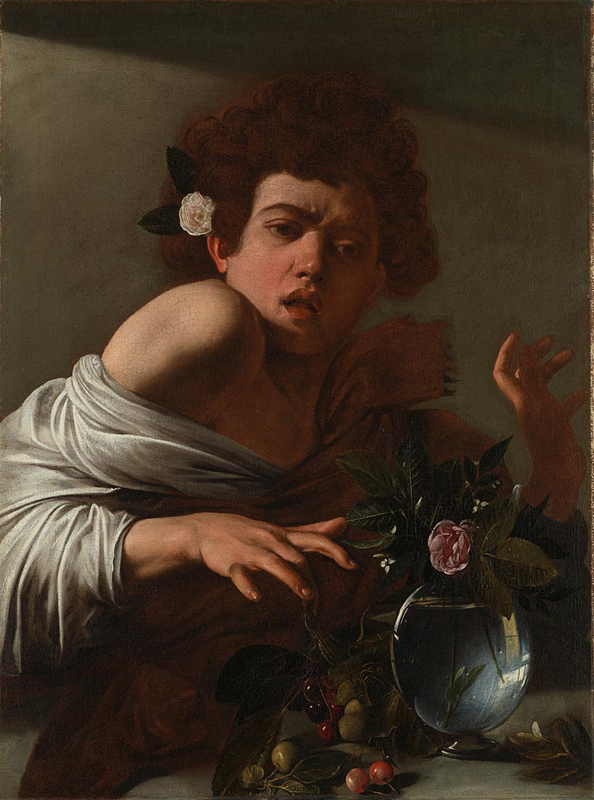
Caravaggio, "The Boy Bitten by a Lizard"
"Boy Bitten by a Lizard" depicts a weak young man who is bitten by a lizard, which clings tenaciously to his fingers, and he flinches in pain. In the foreground is a magnificent still life of fruits with a rose and a sprig of jasmine in a glass vase. If you look closely, you can also see the reflection of the room on the curved surface of the vase. This painting may be a reference to the pain caused by love.
The painting may have been painted by Caravaggio in Rome in the mid-1590s, when the artist was just beginning to become known for his strikingly innovative style. Showing such a moment of action is quite unusual for a painting of the late sixteenth century, but Caravaggio eschewed artistic tradition and painted live models directly on canvas. This gives his work an immediacy and tension that makes them instantly popular. Many copies of the painting were derived in the early 17th century, some of which are even believed to have been created by Caravaggio himself.
Caravaggio's short and turbulent life echoes the dramatic inside and outside of his work. Characterized by exaggerated, dramatic lighting, his paintings were controversial but popular and had a huge influence on later painters throughout Europe.

Sansofeleto "The Praying Virgin"
This is a "Virgin Statue" that people can't take their eyes off of. Dark blue cloak, pale pink skirt, creamy white headpiece against a plain dark background - this devotional painting makes us feel like we are in the same room as the Virgin, her head bowed in quiet prayer. The bright light draws attention to her lustrous blue clothes, the folds of which are painted with expensive ultramarine paint.
Sansofeleto was an Italian Baroque painter known for his obsessive pursuit of Raphael's style, inspired by the work of early artists Raphael and Pietro Perugino.
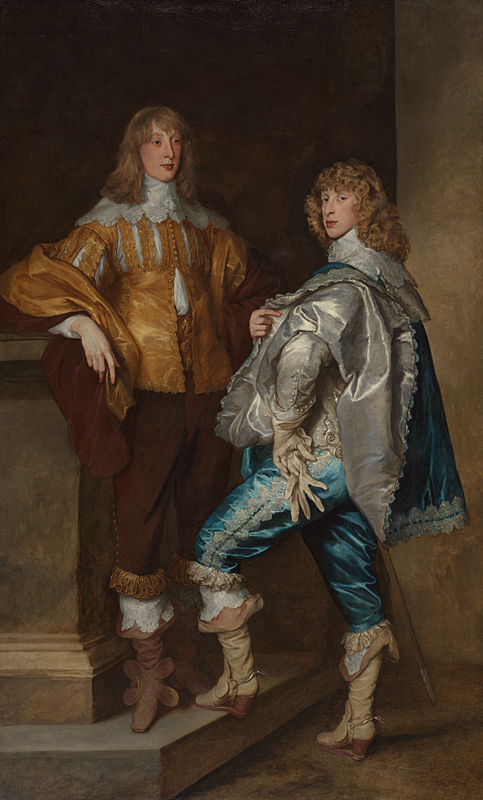
Van Dyck, Lord John Stuart and his Brother Lord Bernard Stuart
This life-size double portrait by Van Dyck shows the youngest sons of Duke Lennox III: Lord John Stuart and his elder brother, Lord Bernard Stuart. Bernard Stuart). They were only about 17 or 8 years old, and they exuded aristocratic air and dressed luxuriously.
Van Dyck's ability to display silk and satin textures made his portraits popular with the nobility at the time. Here, he further enhances the effect by using the clean lines and muted tones of the background to bring out the folds of the garment and the richness of color.
In the picture, he also intensifies the tension between the brothers. They stand together, poses facing each other, both with their left hands on their hips and their torsos turned to the other side. But their eyes do not meet, one leans passively back, while the other, looking directly at us, takes a step forward, clearly showing the spur and sword at his feet.

Rembrandt "Self-Portrait at 63"
Rembrandt's Self-Portrait at 63, when you look at it, you're looking into the eyes of a man in the last year of his life. Rembrandt was 63 at the time and this is one of three self-portraits painted by Rembrandt in the months before his death in 1669. During his 40-year career, he left some 80 self-portraits, far more than any other artist of his generation. He painted self-portraits for a variety of different reasons: to practice different expressions, to experiment with light effects, and to sell to wealthy patrons and collectors.
In this painting, Rembrandt focuses on the textures and colors that depict his own aging face. The drooping wrinkle under his right eye was made by the spinning of a heavy brush. The blemishes on his forehead are formed by splotches of solidified paint.
In this portrait, some see tiredness and helplessness in his somber eyes, some see a hint of self-satisfaction, others a twisted knowing smile. Many later writers and artists saw this as part of his self-examination process - Rembrandt's acceptance of the approaching death to know himself with unwavering honesty. But it's important to note that in the 17th century people had a different view of self-analysis and how the brain worked than we do now. The motivation for Rembrandt's creation may be more immediate - less introspection than a professional fascination with artistic challenges.
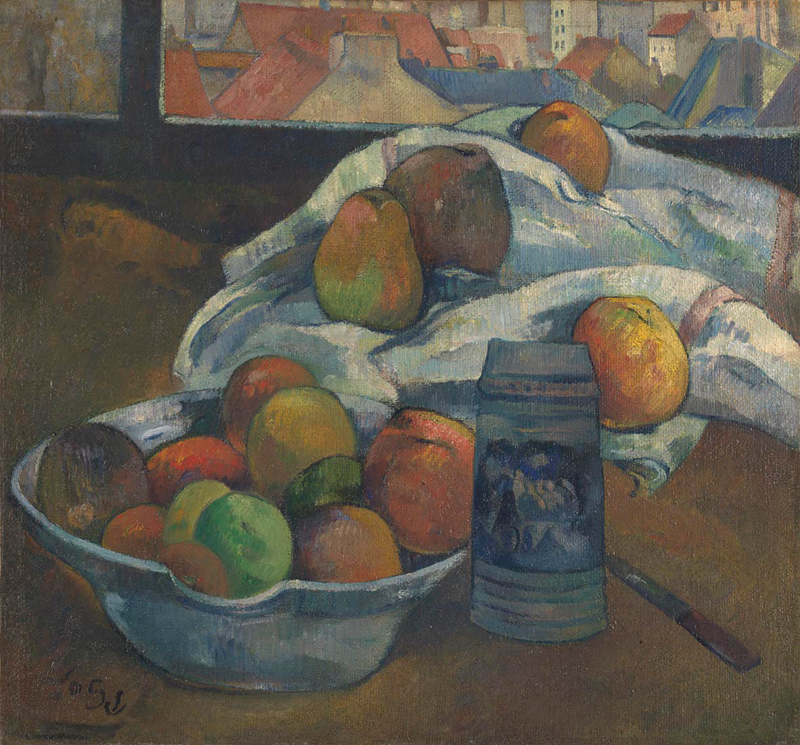
Gauguin, "Fruit-pot and wine-glass in front of the window"
One of Gauguin's favorite paintings is Cezanne's Still Life with Fruit Sauce, Glass and Apples (1879-1880, MoMA, New York), which he acquired around 1880 as a own collection.
This still life pays homage to that painting and repeats many of its elements: fruit, pottery, crumpled tablecloth, and the diagonal knife in the lower right. The truncated diagonal brushstrokes and flattened perspective, where foreground and distance are folded together, are also reminiscent of Cezanne's work.
The narrow strip at the top of the painting and the dense arrangement of buildings together make up the mystery of the painting. The addition of a window frame in the painting seems to suggest that there is a view out of the window, but there is no continuity between the clearly defined large scene and the smaller blurred image next to it. We haven't identified the exact scene yet, it looks more like an urban landscape than the countryside of Brittany, although Gauguin spent a lot of time there when he painted the painting.
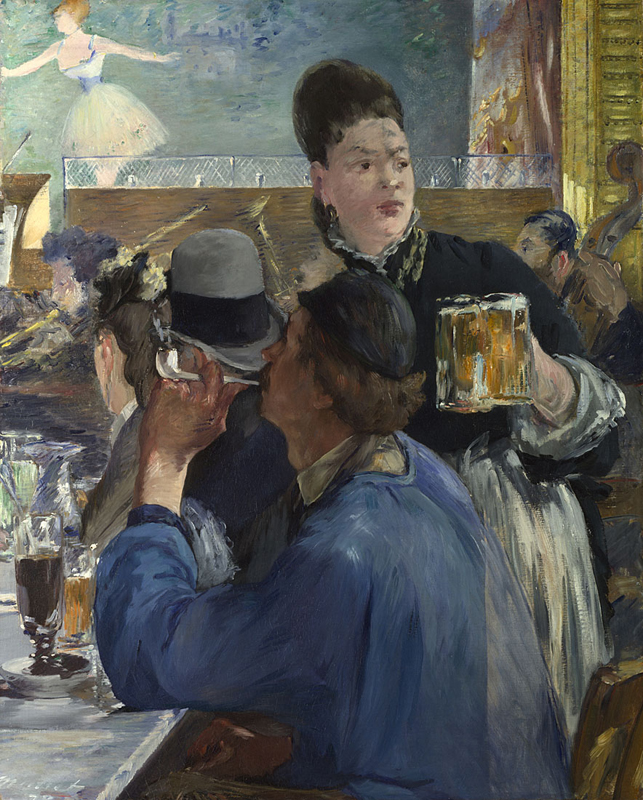
Manet, "A Corner of a Café Concert"
In the mid-19th century, coffee concerts became very popular in France, attracting customers of all classes. These venues are also stylish meeting places for artists and writers, especially those associated with Impressionism. From 1872 until his death in 1883, Manet created many works showing the interiors, terraces and gardens of popular local brasseries, restaurants, cafés and café concerts.
In August 1874, Manet was attracted by the proficiency of the waitresses in the Reichshofen restaurant and began to create large-scale paintings using the restaurant as a scene. During the creative process, he completely changed his plan, splitting it in two, completing each half separately. This cafe snapshot-like painting is the right part of the original large painting. The left half of the painting, titled Au Café, depicts a man and two women sitting on the other side of a table, now in the Reinhardt Kunsthalle in Winterthur, Switzerland. Although Manet reworked each painting separately, it is still clear that they are two halves of the same painting. For example, the table on the left of this image is connected to the table on the right of Au Café, where the shadow of the glass and carafe continues.
In this painting in the collection of the National Gallery, Manet added an extra canvas to the right, expanding the size of the painting and bringing the waitress to the center of the composition. He then redesigned the background, adding the stage, dancers and orchestra, which were drawn in a much looser way than the foreground figures.
A Corner of the Cafe Recital is both a painting and a fragment in itself. The title is very fitting for the subject of the painting, as Manet offers us only a glimpse of the world, not a panorama of it.
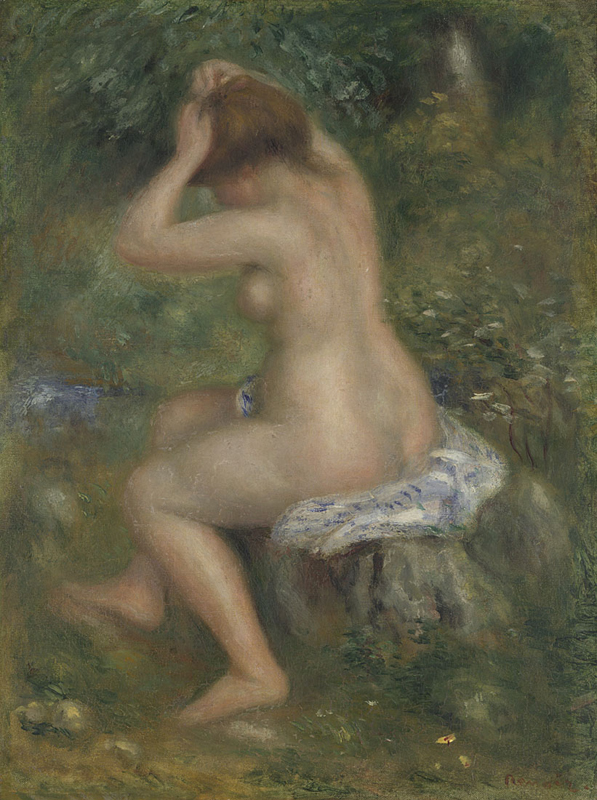
Renoir "The Bather"
Before the 1880s, Renoir rarely painted nudes. He traveled to Italy in 1881, where he was drawn to Roman sculpture and Renaissance painting, which rekindled his interest in depicting the nude in a way that echoed the classical tradition. He began to work on the subject of the human body more frequently, and this "Bather" may be one of a series of works he produced in the second half of the 1880s.
The tradition of nude subjects can be traced back to ancient Greek mythology, and Renoir's work clearly reflects the long tradition of classical nude painting. He also added some distinctly contemporary elements, such as the towel or the striped fabric on the dress the model was sitting on, and the hair she was fixing (or unraveling), which was one of the fashions of the time.
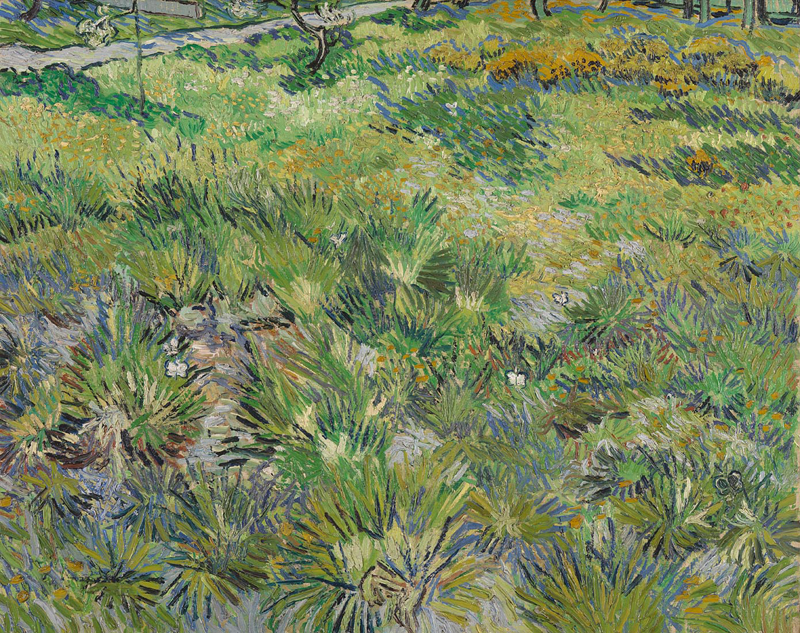
Van Gogh's "Long Meadow and Butterflies"
Vincent van Gogh painted this meadow while undergoing treatment at the Saint-Paul de Mausole near the town of St-Rémy in southern France. While in the hospital, he created some sketches and paintings by looking down at the small overgrown garden through the window. With no horizon or sky in the picture, Van Gogh concentrates almost exclusively on the grass and some white butterflies, but an inconspicuous path at the top of the frame creates an effect of depth. Compared to the boundary formed by the smaller diameters, the remaining space is open and may extend beyond the canvas. The grass is drawn with strokes of different lengths and shorts, as in the description of growing in clusters.
Van Gogh's interest in depicting details of nature may have been influenced by what he had learned about Japanese culture, and he wrote to Theo that "the wise Japanese...he studied only one grass. But this piece The blades of grass lead him to draw all the plants - then the seasons, the splendid views of the landscape, finally the animals, then the figures... These pure Japanese live in nature as if they were flowers themselves, they Doesn't it teach us a true religion?". In painting, however, Van Gogh's detailed study of nature, especially vegetation and flowers, has important precedents in both Renaissance art and 17th-century Dutch painting.
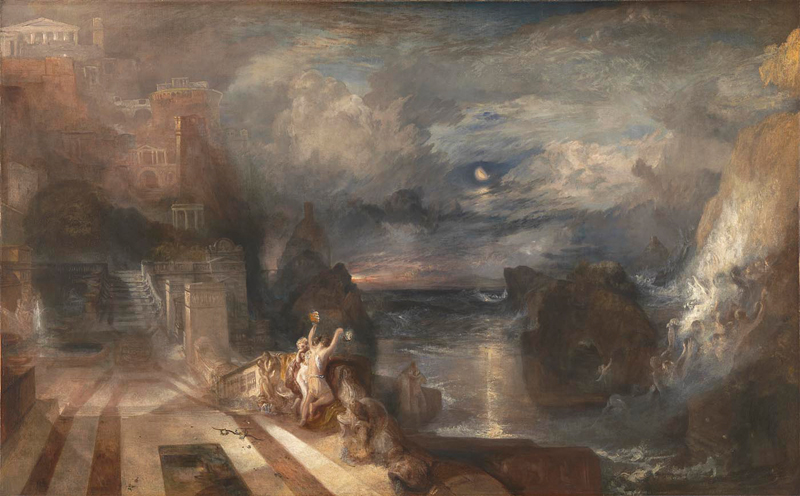
Turner, The Parting of Hero and Leander
Joseph Mallord William Turner is one of Britain's most famous and skilled artists. Turner's oil painting "The Parting of Hero and Leander" was written before 1837, and the theme was derived from the most famous love poem "Hero and Leander" by the ancient Greek writer and poet Moses. Hero is Aphrodite's priestess, and Leander swims across the Dardanelles to meet Hero every night, and Hero guides Leander with a torch every night. On a stormy night, the torch that led the way was blown out by the storm, Leander was lost and drowned, and Heroine jumped into the sea in grief.
The lovers are not the biggest figures in the painting. Turner broke with the tradition of history painting, which required the main character to be at or near the center of the picture. They were almost hidden in the shadows by the water as Leander prepared to leave. On the platform above them, a winged Cupid threw his bow and quiver on the ground, holding up a lamp and a torch. Around them, Turner constructed an imaginary site with various classical architectural elements, wide staircases and huge mosaic floors. On the right, an exotic "Moorish" tower representing Abydos on the Turkish coast, just behind the massive, jagged rocks where ghostly sea nymphs gather.
As Turner's verse puts it, the night is ending because "love still lingers." Although dawn had just broken, a crescent moon was still clearly visible in the turbulent blue-black sky. Turner uses darkness and deep shadows to enhance the drama of the scene, perhaps suggesting an impending tragedy. Because Leander left Hero and never came back.

Poussin "The Cultivation of the Dionysian"

Gossett, The Young Princess (Dorothea of Denmark)
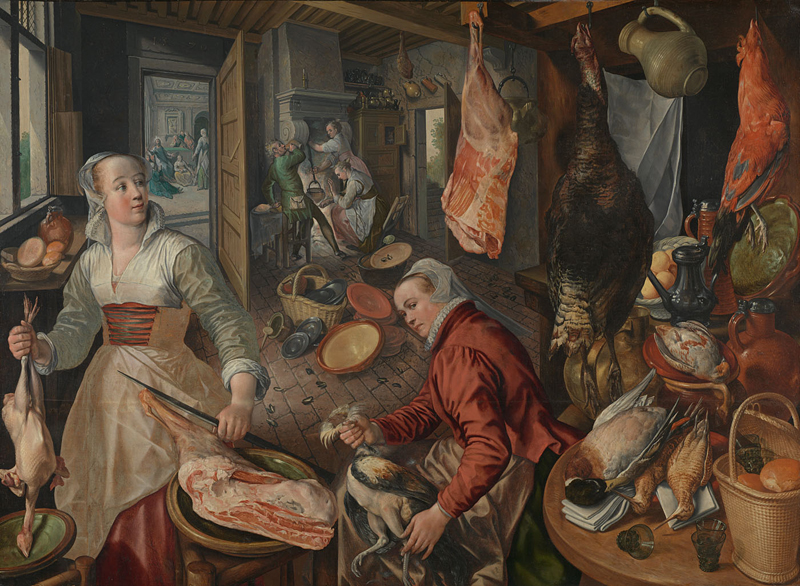
The Four Elements: Fire

"Concert in the Courtyard" by de Hooch

Canaletto, Venice: Basilica of St. Peter in the Castle District

Constable's "Stratford Mill"
(The introduction of the works in this article is compiled and organized according to the official website of the British National Gallery and official Weibo)
